Yanzhang He
Google Inc. USA
Extreme Encoder Output Frame Rate Reduction: Improving Computational Latencies of Large End-to-End Models
Feb 27, 2024Abstract:The accuracy of end-to-end (E2E) automatic speech recognition (ASR) models continues to improve as they are scaled to larger sizes, with some now reaching billions of parameters. Widespread deployment and adoption of these models, however, requires computationally efficient strategies for decoding. In the present work, we study one such strategy: applying multiple frame reduction layers in the encoder to compress encoder outputs into a small number of output frames. While similar techniques have been investigated in previous work, we achieve dramatically more reduction than has previously been demonstrated through the use of multiple funnel reduction layers. Through ablations, we study the impact of various architectural choices in the encoder to identify the most effective strategies. We demonstrate that we can generate one encoder output frame for every 2.56 sec of input speech, without significantly affecting word error rate on a large-scale voice search task, while improving encoder and decoder latencies by 48% and 92% respectively, relative to a strong but computationally expensive baseline.
USM-Lite: Quantization and Sparsity Aware Fine-tuning for Speech Recognition with Universal Speech Models
Jan 03, 2024Abstract:End-to-end automatic speech recognition (ASR) models have seen revolutionary quality gains with the recent development of large-scale universal speech models (USM). However, deploying these massive USMs is extremely expensive due to the enormous memory usage and computational cost. Therefore, model compression is an important research topic to fit USM-based ASR under budget in real-world scenarios. In this study, we propose a USM fine-tuning approach for ASR, with a low-bit quantization and N:M structured sparsity aware paradigm on the model weights, reducing the model complexity from parameter precision and matrix topology perspectives. We conducted extensive experiments with a 2-billion parameter USM on a large-scale voice search dataset to evaluate our proposed method. A series of ablation studies validate the effectiveness of up to int4 quantization and 2:4 sparsity. However, a single compression technique fails to recover the performance well under extreme setups including int2 quantization and 1:4 sparsity. By contrast, our proposed method can compress the model to have 9.4% of the size, at the cost of only 7.3% relative word error rate (WER) regressions. We also provided in-depth analyses on the results and discussions on the limitations and potential solutions, which would be valuable for future studies.
Partial Rewriting for Multi-Stage ASR
Dec 08, 2023Abstract:For many streaming automatic speech recognition tasks, it is important to provide timely intermediate streaming results, while refining a high quality final result. This can be done using a multi-stage architecture, where a small left-context only model creates streaming results and a larger left- and right-context model produces a final result at the end. While this significantly improves the quality of the final results without compromising the streaming emission latency of the system, streaming results do not benefit from the quality improvements. Here, we propose using a text manipulation algorithm that merges the streaming outputs of both models. We improve the quality of streaming results by around 10%, without altering the final results. Our approach introduces no additional latency and reduces flickering. It is also lightweight, does not require retraining the model, and it can be applied to a wide variety of multi-stage architectures.
Massive End-to-end Models for Short Search Queries
Sep 22, 2023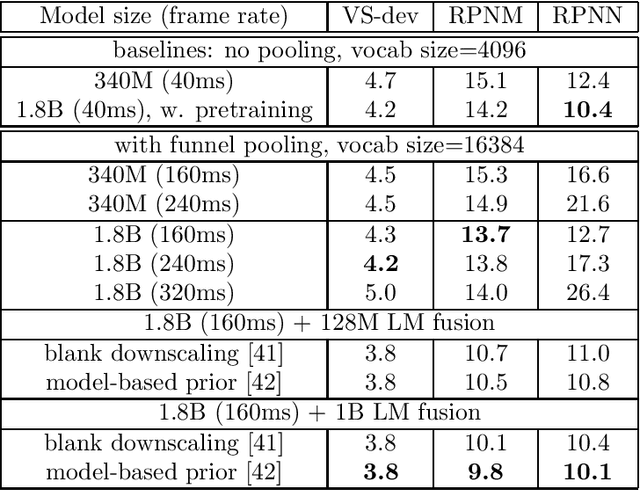
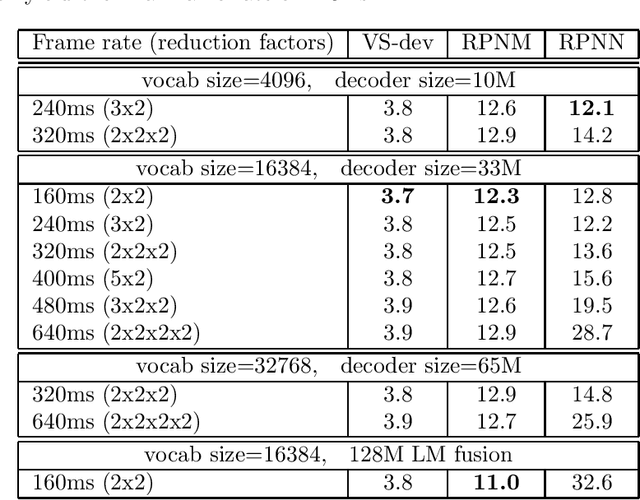
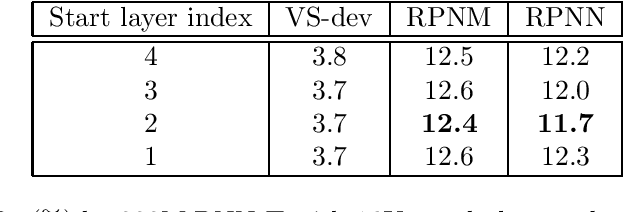
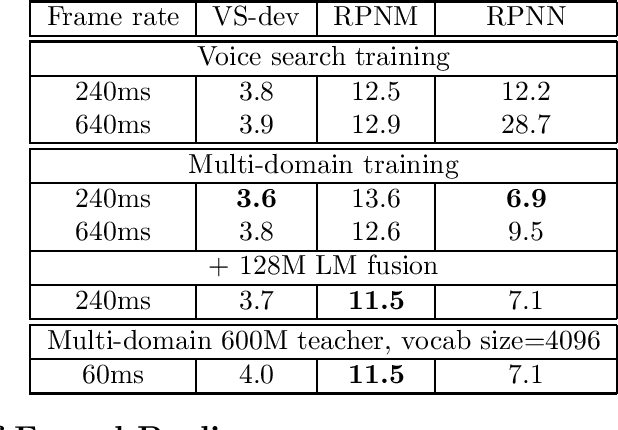
Abstract:In this work, we investigate two popular end-to-end automatic speech recognition (ASR) models, namely Connectionist Temporal Classification (CTC) and RNN-Transducer (RNN-T), for offline recognition of voice search queries, with up to 2B model parameters. The encoders of our models use the neural architecture of Google's universal speech model (USM), with additional funnel pooling layers to significantly reduce the frame rate and speed up training and inference. We perform extensive studies on vocabulary size, time reduction strategy, and its generalization performance on long-form test sets. Despite the speculation that, as the model size increases, CTC can be as good as RNN-T which builds label dependency into the prediction, we observe that a 900M RNN-T clearly outperforms a 1.8B CTC and is more tolerant to severe time reduction, although the WER gap can be largely removed by LM shallow fusion.
2-bit Conformer quantization for automatic speech recognition
May 26, 2023Abstract:Large speech models are rapidly gaining traction in research community. As a result, model compression has become an important topic, so that these models can fit in memory and be served with reduced cost. Practical approaches for compressing automatic speech recognition (ASR) model use int8 or int4 weight quantization. In this study, we propose to develop 2-bit ASR models. We explore the impact of symmetric and asymmetric quantization combined with sub-channel quantization and clipping on both LibriSpeech dataset and large-scale training data. We obtain a lossless 2-bit Conformer model with 32% model size reduction when compared to state of the art 4-bit Conformer model for LibriSpeech. With the large-scale training data, we obtain a 2-bit Conformer model with over 40% model size reduction against the 4-bit version at the cost of 17% relative word error rate degradation
RAND: Robustness Aware Norm Decay For Quantized Seq2seq Models
May 24, 2023



Abstract:With the rapid increase in the size of neural networks, model compression has become an important area of research. Quantization is an effective technique at decreasing the model size, memory access, and compute load of large models. Despite recent advances in quantization aware training (QAT) technique, most papers present evaluations that are focused on computer vision tasks, which have different training dynamics compared to sequence tasks. In this paper, we first benchmark the impact of popular techniques such as straight through estimator, pseudo-quantization noise, learnable scale parameter, clipping, etc. on 4-bit seq2seq models across a suite of speech recognition datasets ranging from 1,000 hours to 1 million hours, as well as one machine translation dataset to illustrate its applicability outside of speech. Through the experiments, we report that noise based QAT suffers when there is insufficient regularization signal flowing back to the quantization scale. We propose low complexity changes to the QAT process to improve model accuracy (outperforming popular learnable scale and clipping methods). With the improved accuracy, it opens up the possibility to exploit some of the other benefits of noise based QAT: 1) training a single model that performs well in mixed precision mode and 2) improved generalization on long form speech recognition.
Sharing Low Rank Conformer Weights for Tiny Always-On Ambient Speech Recognition Models
Mar 15, 2023Abstract:Continued improvements in machine learning techniques offer exciting new opportunities through the use of larger models and larger training datasets. However, there is a growing need to offer these new capabilities on-board low-powered devices such as smartphones, wearables and other embedded environments where only low memory is available. Towards this, we consider methods to reduce the model size of Conformer-based speech recognition models which typically require models with greater than 100M parameters down to just $5$M parameters while minimizing impact on model quality. Such a model allows us to achieve always-on ambient speech recognition on edge devices with low-memory neural processors. We propose model weight reuse at different levels within our model architecture: (i) repeating full conformer block layers, (ii) sharing specific conformer modules across layers, (iii) sharing sub-components per conformer module, and (iv) sharing decomposed sub-component weights after low-rank decomposition. By sharing weights at different levels of our model, we can retain the full model in-memory while increasing the number of virtual transformations applied to the input. Through a series of ablation studies and evaluations, we find that with weight sharing and a low-rank architecture, we can achieve a WER of 2.84 and 2.94 for Librispeech dev-clean and test-clean respectively with a $5$M parameter model.
E2E Segmentation in a Two-Pass Cascaded Encoder ASR Model
Nov 28, 2022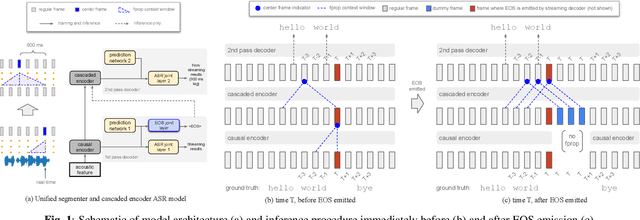

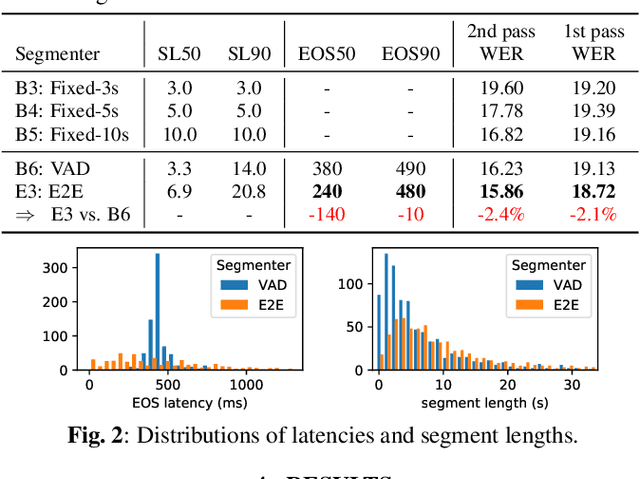

Abstract:We explore unifying a neural segmenter with two-pass cascaded encoder ASR into a single model. A key challenge is allowing the segmenter (which runs in real-time, synchronously with the decoder) to finalize the 2nd pass (which runs 900 ms behind real-time) without introducing user-perceived latency or deletion errors during inference. We propose a design where the neural segmenter is integrated with the causal 1st pass decoder to emit a end-of-segment (EOS) signal in real-time. The EOS signal is then used to finalize the non-causal 2nd pass. We experiment with different ways to finalize the 2nd pass, and find that a novel dummy frame injection strategy allows for simultaneous high quality 2nd pass results and low finalization latency. On a real-world long-form captioning task (YouTube), we achieve 2.4% relative WER and 140 ms EOS latency gains over a baseline VAD-based segmenter with the same cascaded encoder.
Unified End-to-End Speech Recognition and Endpointing for Fast and Efficient Speech Systems
Nov 01, 2022Abstract:Automatic speech recognition (ASR) systems typically rely on an external endpointer (EP) model to identify speech boundaries. In this work, we propose a method to jointly train the ASR and EP tasks in a single end-to-end (E2E) multitask model, improving EP quality by optionally leveraging information from the ASR audio encoder. We introduce a "switch" connection, which trains the EP to consume either the audio frames directly or low-level latent representations from the ASR model. This results in a single E2E model that can be used during inference to perform frame filtering at low cost, and also make high quality end-of-query (EOQ) predictions based on ongoing ASR computation. We present results on a voice search test set showing that, compared to separate single-task models, this approach reduces median endpoint latency by 120 ms (30.8% reduction), and 90th percentile latency by 170 ms (23.0% reduction), without regressing word error rate. For continuous recognition, WER improves by 10.6% (relative).
A Language Agnostic Multilingual Streaming On-Device ASR System
Aug 29, 2022
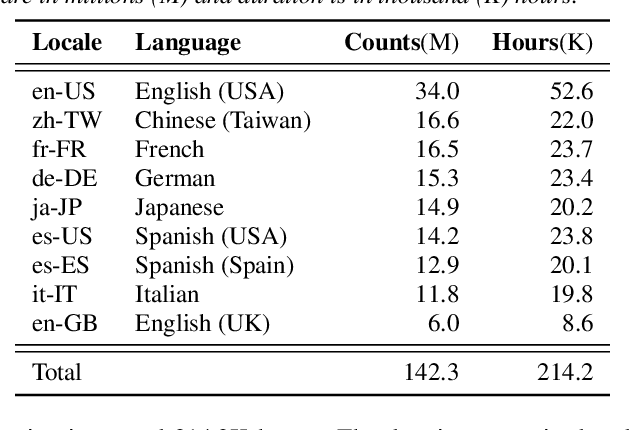


Abstract:On-device end-to-end (E2E) models have shown improvements over a conventional model on English Voice Search tasks in both quality and latency. E2E models have also shown promising results for multilingual automatic speech recognition (ASR). In this paper, we extend our previous capacity solution to streaming applications and present a streaming multilingual E2E ASR system that runs fully on device with comparable quality and latency to individual monolingual models. To achieve that, we propose an Encoder Endpointer model and an End-of-Utterance (EOU) Joint Layer for a better quality and latency trade-off. Our system is built in a language agnostic manner allowing it to natively support intersentential code switching in real time. To address the feasibility concerns on large models, we conducted on-device profiling and replaced the time consuming LSTM decoder with the recently developed Embedding decoder. With these changes, we managed to run such a system on a mobile device in less than real time.
 Add to Chrome
Add to Chrome Add to Firefox
Add to Firefox Add to Edge
Add to Edge